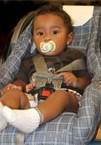Car Seat Tips For Child Passenger Safety Week
 |
WORCESTER, MA--Sept. 11, 2013: A stunning statistic is that motor vehicle crashes are the leading cause of death for children. And, for every fatality caused by a motor vehicle crash, about 400 more children are treated for car accident related injuries. In recognition of the upcoming Child Passenger Safety Week, The Hanover Insurance Group, Inc. offers safety tips for using child restraint systems properly.
"Proper use of car and booster seats have been proven to save lives and reduce the number of injuries in car crashes," said Mark R. Desrochers, president, personal lines insurance at The Hanover. "But, child restraint systems often are used incorrectly, and in many cases are misused in a way that could actually increase a child's risk of injury or death during a crash. We believe that proactive education on proper usage of car seats for children will help save lives and reduce injuries."
To help keep your children safe when travelling in a car, the following safety tips are recommended:
Car Seat Safety
Children should be rear-facing until they reach the maximum height and/or weight listed for their given car seat model, usually about the age of two. When using a rear-facing only seat, make sure your car seat base is installed at the correct angle. Babies must ride sitting semi-reclined so their airways remain open. Most infant car seats have built-in angle indicators or adjustors to assist in this process. Any child who has outgrown the weight or height limit for his/her rear-facing car seat should use a forward-facing car seat until they reach either four years old or 40 pounds. A child has outgrown his or her forward facing car seat when the top of his or her ears reach the top of the seat. Always use a five-point harness, and properly position the harness on your child per manufacturer specifications. For rear-facing seats, harness straps should enter the seat below the child's shoulders. For forward-facing seats, they should be at or above the shoulder. Harness straps should lay flat, with no sagging or twisting. The harness must be snug so you cannot pinch a fold in the harness strap at the shoulder after buckling. Place the top of the chest clip at armpit level as chest clips placed too low can cause internal injuries, since this part of the body is not protected by the rib cage. Installations should be tight. You should not be able to move your car seat side to side more than one inch. That said, you should use either the latch system or the seat belt but not both. The car seat should be able to move and flex a small amount to absorb some impact. Car seat harness straps should not be washed. Submerging straps in even plain water can compromise the fire-retardant chemicals that are on them, and using detergents or other cleaning agents can weaken the integrity of the straps. Children should not wear winter coats in harnessed car seats. The added bulk can prevent proper harness tightening. It can also compress during an accident, leaving too much room in the harness and allowing the child to shift dangerously.
Booster Seat Safety
All children whose weight or height is above the forward-facing limit should use a belt-positioning booster seat until the vehicle seat belt fits properly. This typically is when they have reached four feet nine inches in height and are between eight and 12 years of age. When using a booster seat, make sure the lap belt lies low and snug across the child's upper thighs, below the hip bones. The shoulder belt should cross the center of your child's chest and shoulder. It should not cut across his/her neck or face. Never put the shoulder belt behind your child's back or under his or her arm.
General Car Safety
The safest placement for kids is the center of the backseat. Children younger than 13 who ride in the front seat can risk serious injury – not only from other cars, but from the very airbags that are designed to protect passengers. Be sure to register your child's car safety seat. In the event of a recall, the manufacturer will reach you by mail to let you know of the recall and what steps you should take. Proper installation of child car seats is critical to their function. The Hanover recommends having your seats inspected. For a list of inspection sites closest to you, please visit the National Highway Traffic Safety Administration NHTSA . In the event of a car accident, be sure to check with your independent agent to determine whether your car seat needs to be replaced. At The Hanover, we believe so strongly in child safety, we automatically include certain car safety coverage with all of our Hanover Platinum Protection policies. We provide coverage up to $300 to replace a damaged car seat when the damage takes place as a result of a covered loss.


